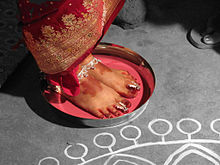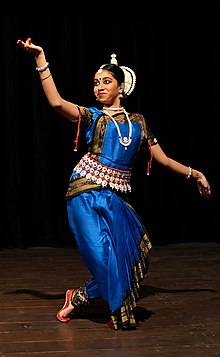Alta (dye)

Alta (Bengali: আলতা), Lakshaya Rasa, Alah, Mahavar is a red dye that is applied to the hands and feet of women, mainly in the Indian subcontinent.[1][2][3][4][5][6][7] It is applied with a cotton swab or brush to the hands and feet during marriage ceremonies and festivals.
Alta is originally produced from red-lac (dye) derived from Lac resin, although today it is mainly replaced with synthetic dyes.[8]
Early history
Early mention of Alta comes from Upanishads where it is known as Lakshaya Rasa meaning red-lac dye pigment derived from lac resin as one of sixteen adornments of woman known as Solah-Shringar.[9][10]
Cultural significance
Bengali culture


Alta has great cultural significance in Bengali culture.[11][12][3] Regardless of religious beliefs, Bengali women traditionally adorn their hands and feet with alta for marriage[13][7] and cultural festivals like Pahela Baishakh, Pahela Falgun and others.[14][15][16] Wearing Alta on Durga Pooja is a common ritual for Odia and Bengali women.[17]
Odia culture

Alta is also significant in Odisha. It can be commonly seen worn by Odissi classical dancers on hands and feet while performing. It is especially prevalent during Raja or Mithun Sanakranti, which is a three-day festival celebrating womanhood (menstruation).[18] During this festival, as a part of the ritual, women apply alta on their feet symbolising fertility and auspiciousness. Alta and turmeric is also applied during marriages in Odia culture.
Nepali
In Nepal it is known as 'Alah' and it is important part of wedding, religious rituals and festivals. [19]
Text is available under the CC BY-SA 4.0 license; additional terms may apply.
Images, videos and audio are available under their respective licenses.
